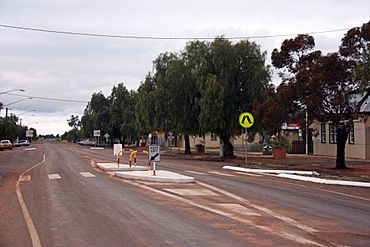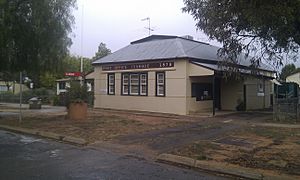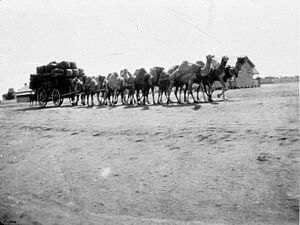Ivanhoe, New South Wales facts for kids
Quick facts for kids IvanhoeNew South Wales |
|
|---|---|

Cobb Highway in Ivanhoe
|
|
| Population | 162 (2021 census) |
| Postcode(s) | 2878 |
| Elevation | 90.0 m (295 ft) |
| Location |
|
| LGA(s) | Central Darling Shire |
| County | Manara |
| State electorate(s) | Barwon |
| Federal Division(s) | Parkes |
Ivanhoe is a very small town in New South Wales, Australia. It's located on the Cobb Highway, a major road that connects different parts of the state. You can find Ivanhoe between two important rivers: the Lachlan and the Darling.
This little town acts as a helpful service stop for people living in the surrounding area. One cool thing about Ivanhoe is its super wide main street! In 2021, about 162 people called Ivanhoe home. The town got its name from a famous book called Ivanhoe by Sir Walter Scott. It was founded in the early 1870s and was an important stop for coaches and livestock traveling between towns like Wilcannia and Balranald.
Contents
History of Ivanhoe
Ivanhoe is located on land that was once part of the Wangaibon people's traditional country. In 1869, a smart businessman named George Brown Williamson bought some land here. He was a postmaster and store owner from a nearby town. Williamson picked this spot because it was where two important roads met. He thought it would be a great place for a new business.
At first, getting water in Ivanhoe was tough. People had to bring drinking water from Kilfera Lake, which was 25 kilometers away! In 1871, the first hotel, the Ivanhoe Hotel, opened its doors. A post office also started in 1874 at Williamson's store. By 1876, two more hotels opened, showing the town was growing.
In 1879, police came to Ivanhoe to protect people from local bushrangers. These were outlaws who lived in the bush. In 1883, a telegraph line was built, allowing people to send messages quickly. At that time, Ivanhoe had about 50 residents, a blacksmith, two hotels, two stores, and a few houses.
By 1884, Ivanhoe became a major stop for Cobb & Co, a famous coach company. They would change horses here for their long journeys. The town also got mounted police in 1885. The Ivanhoe Jockey Club held its first horse race in 1885, and races continued for many years. A school opened in 1889, but the summer heat was a big problem. Sometimes, the school even had to close during very dry periods.
Ivanhoe officially became a town in 1890. A new Post Office building was built in 1898, and it's still standing today! George Williamson, the town's founder, passed away in 1907.
In 1925, a railway line connected Ivanhoe to Sydney. Two years later, the line reached Broken Hill. This railway became a key part of the transcontinental line, linking Sydney all the way to Perth across Australia.
Ivanhoe Heritage Trail
If you visit Ivanhoe, you can explore the Ivanhoe Heritage Trail. It's a great way to learn about the town's past. Along the trail, you'll find signs that tell stories about:
- The arrival of the railway
- The town's water supply
- The Post Office
- Stories about bushrangers
- Places where people found water
- The Cobb Highway
- Memories from local people
Most of these historical spots are very close to the main street. You can get a pamphlet about the trail from the post office.
Climate in Ivanhoe
Ivanhoe has a hot, dry climate, which means it gets very hot summers and short, cool winters. In January, the average high temperature is about 34.9°C. In July, the average high is around 16.5°C.
The hottest temperature ever recorded in Ivanhoe was a scorching 48.5°C in February 2004. The coldest was -6.2°C in July 1982. The town gets about 306 millimeters of rain each year.
| Climate data for Ivanhoe Post Office (1939–2013, rainfall 1884–2016); 85 m AMSL; 32.90° S, 144.30° E | |||||||||||||
|---|---|---|---|---|---|---|---|---|---|---|---|---|---|
| Month | Jan | Feb | Mar | Apr | May | Jun | Jul | Aug | Sep | Oct | Nov | Dec | Year |
| Record high °C (°F) | 48.0 (118.4) |
48.5 (119.3) |
44.7 (112.5) |
39.0 (102.2) |
30.8 (87.4) |
26.8 (80.2) |
26.0 (78.8) |
32.2 (90.0) |
39.2 (102.6) |
40.5 (104.9) |
45.6 (114.1) |
46.4 (115.5) |
48.5 (119.3) |
| Mean daily maximum °C (°F) | 34.9 (94.8) |
34.0 (93.2) |
30.7 (87.3) |
25.7 (78.3) |
20.4 (68.7) |
17.1 (62.8) |
16.5 (61.7) |
18.7 (65.7) |
22.7 (72.9) |
26.4 (79.5) |
30.0 (86.0) |
33.3 (91.9) |
25.9 (78.6) |
| Mean daily minimum °C (°F) | 18.1 (64.6) |
18.0 (64.4) |
14.7 (58.5) |
10.3 (50.5) |
6.8 (44.2) |
4.4 (39.9) |
3.6 (38.5) |
4.7 (40.5) |
7.2 (45.0) |
10.5 (50.9) |
13.8 (56.8) |
16.3 (61.3) |
10.7 (51.3) |
| Record low °C (°F) | 8.0 (46.4) |
6.6 (43.9) |
4.5 (40.1) |
−0.5 (31.1) |
−5.6 (21.9) |
−5.6 (21.9) |
−6.2 (20.8) |
−4.0 (24.8) |
−1.2 (29.8) |
0.2 (32.4) |
2.0 (35.6) |
6.0 (42.8) |
−6.2 (20.8) |
| Average precipitation mm (inches) | 29.9 (1.18) |
28.4 (1.12) |
29.5 (1.16) |
19.5 (0.77) |
26.9 (1.06) |
26.8 (1.06) |
23.0 (0.91) |
23.5 (0.93) |
21.9 (0.86) |
28.1 (1.11) |
24.0 (0.94) |
25.8 (1.02) |
306.0 (12.05) |
| Average precipitation days (≥ 0.2 mm) | 3.3 | 3.1 | 3.3 | 3.2 | 4.8 | 5.9 | 5.9 | 5.7 | 4.8 | 4.8 | 3.6 | 3.6 | 52 |
| Average afternoon relative humidity (%) | 25 | 28 | 31 | 38 | 49 | 55 | 53 | 44 | 35 | 30 | 26 | 25 | 37 |
| Source: Bureau of Meteorology, Ivanhoe Post Office (all years) | |||||||||||||
Ivanhoe Warakirri Centre
The Ivanhoe Warakirri Centre used to be a place where male inmates could stay. It was a minimum security center, meaning it was for prisoners who were not considered a high risk. Many of the inmates were Aboriginal. They helped with cleaning and maintenance, and also worked on community projects. The center also offered classes to help inmates learn new skills.
In June 2020, the center closed. The facility and 26 houses were sold to Tronox Mining Company. This company needed housing for its staff who work at the Atlas/Campaspe titanium mine. This mine is about 140 km southwest of Ivanhoe. The mine digs up special sand that contains heavy minerals. These minerals are then trucked to a new rail loading area near Ivanhoe. From there, they are sent by train to Broken Hill for more processing.
Ivanhoe is now an important place for the Atlas-Campaspe mine's operations. This means there will be new job and business chances for people in the area.
Sports Teams
Ivanhoe has its own rugby league team called the Ivanhoe Roosters. They play in the Group 17 Rugby League competition.
Railway Connections
The Ivanhoe railway station opened on August 19, 1925. It's part of the Broken Hill railway line. Even though the station isn't staffed anymore, trains still stop there.
The Outback Xplorer train stops in Ivanhoe on Mondays (heading to Broken Hill) and Tuesdays (heading to Sydney). Another famous train, the Indian Pacific, also passes through Ivanhoe. It goes to Sydney on Tuesdays and to Adelaide and Perth on Thursdays, but it doesn't stop in Ivanhoe.
The main part of Ivanhoe town is about three kilometers north of the railway station. When the railway first opened, a separate "railway town" was built next to the station. This area had workshops, houses for railway workers, and places to fix trains. Many of these buildings are now part of the Ivanhoe Warakirri Centre.
Ivanhoe is still a place where two trains can meet and pass each other on the railway line. There's a long section of double track for this purpose.
Road Routes
Ivanhoe is located on the Cobb Highway, which is National Route 75. This highway runs generally north and south between Moama and Wilcannia. Ivanhoe is 182 km from Wilcannia to the north and 210 km from Hay to the south.
There's also a local gravel road from Ivanhoe to Menindee, which is 205 km long. This road can only be used when the weather is dry. Most of the Cobb Highway is paved, but there's still a small dirt section north of Mount Manara. The Cobb Highway north of Ivanhoe is generally in better condition than the section south of town. Sometimes, major flooding can close parts of the Cobb Highway, making it harder to get into Ivanhoe.






